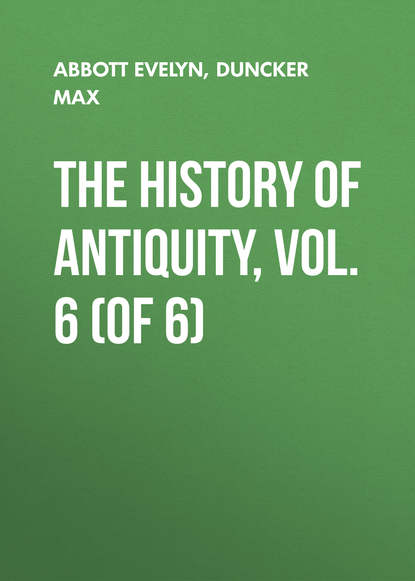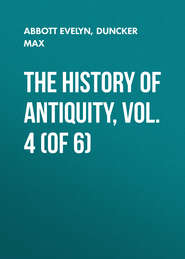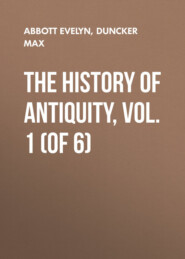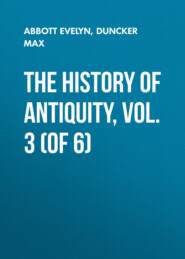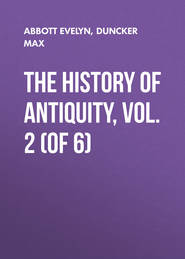По всем вопросам обращайтесь на: info@litportal.ru
(©) 2003-2024.
✖
The History of Antiquity, Vol. 6 (of 6)
Настройки чтения
Размер шрифта
Высота строк
Поля
Xenoph. "Anab." 1, 8.
429
Herod. 7, 218, 226; Xenoph. "Cyri Inst." 8, 8, 22, 23.
430
Herod. 9, 20, 23, 49.
431
Above, p. 303. Herod. 1, 162, 168; 4, 200; 5, 115; Polyaen. "Strateg." 7, 2, 5.
432
The name in Hebrew is Shushan, among the Assyrians, Shusan, hodie, Shush.
433
Loftus, "Travels in Susiana," p. 425 ff. Nöldeke ("Göttingen G. G." 1874, s. 173 ff.) has treated exhaustively of the various names of ancient Elam, as Susiana is invariably called among the Assyrians, Babylonians, and Hebrews. He proves that the name Κισσίη which is in use among the older Greeks, Aeschylus, Hecataeus, and Herodotus, must be derived from the Kossaeans, a tribe who inhabited the northern and higher part of Susiana, and the mountainous edge towards Iran. Of later writers Polybius only uses the name Cissians, who also uses the name Matieni in the sense of Herodotus. Uwaya, the name common among the Persians for Susiana, is taken from the Uxians, who were the eastern neighbours of Persia, i. e. the tribe in Susiana which dwelt nearest to Persia; it is retained in the new Persian Chuz and Chusistan. Among the Greeks the name Elymaeans is first used by the companions of Alexander as the name for a tribe, and then in the second century B.C. as the name of a new kingdom which restored the ancient Elam. Yet to this tribe which inhabited the plain and the hills of Susa and Shuster was due the foundation and government of the kingdom which once ruled in the valley of the Euphrates, which so long resisted the Assyrians, but was entirely unknown to the Greeks. The rivers of Susiana are difficult to fix, as both Persian and native names are indifferently used. The name Choaspes, which contains açpa, is plainly Persian; it is no doubt the Kerkha. On the Eulaeus, Koprates, and Pasitigris, see Droysen, "Hellenismus," 12, 266 n.
434
Aesch. "Pers." 16, 120; Athen. p. 513; Strabo, p. 728, 731, 739; Diod. 17, 65.
435
Polyb. 5, 48.
436
Plin. "Hist. Nat." 6, 31; Daniel viii. 2, 16.
437
"Pers." 3, 4, 159, 160.
438
Ael. "Hist. An." 1, 59.
439
Ménant, "Achaemenides," p. 140, 141; Oppert, "Peuple des Mèdes," p. 229.
440
Curtius, 5, 4.
441
Diod. 17, 71.
442
Oppert, "Peuple des Mèdes," 196.
443
Oppert, loc. cit. 19, 148; Spiegel, "Keilinschriften," s. 49; Schrader, "Assyr. Babyl. Keilinschriften," s. 363.
444
Texier, "Description," pl. 100.
445
Impressions of seals which have been discovered in the palace of Sennacherib at Kuyundshik, represent the king of Assyria in precisely the same position. – Layard, "Nineveh and Babylon," p. 154, 161.
446
Esther i. 6, 7.
447
Inscriptions H. and J. Oppert, "Journal Asiatique," 19, 141; Spiegel, "Keilinschriften," s. 49. Oppert now translates aniya not by "enemy" but literally by "the other;" by which Angromainyu would be meant: "Peuple des Mèdes," p. 199.
448
Viçadahyaus; Spiegel, loc. cit. s. 57; Benfey, "Keilinschriften," s. 63-65; Schrader, loc. cit. s. 364.
449
Above, p. 272 n.
450
Oppert. "Z. D. M. G." 11, 133 ff.; Mordtmann, loc. cit. 16, 109 ff.; Spiegel, "Keilinschriften," s. 52; Schrader, loc. cit. s. 361.
451
Above, p. 272 n., 307.
452
So the Babylonian text.
453





